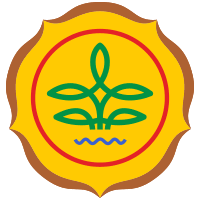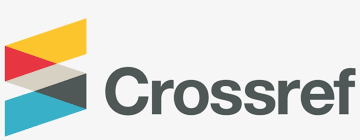Pengendalian Hama Terpadu Berbasis Rekayasa Ekologi pada Agroekosistem Padi untuk Meningkatkan Peran Musuh Alami
Abstract
Keywords
Full Text:
PDFReferences
Abidin, Z., Leksono, A. S., Yanuwiadi, B., and Purnomo, M. 2020. Refugia effect on arthropods in an organic paddy field
in Malang District, East Java, Indonesia. Biodiversitas 21(4) : 1415–1421.
Afandhi, A. 2020. Rice farming with application of integrated pest management (IPM): analysis of social and economic
sustainability (Case Study in Besur Village, Lamongan District). Habitat 31(2) : 109–114.
Akter, M. S., Siddique, S. S., Momotaz, R., Arifunnahar, M., Alam, K. M., and Mohiuddin, S. J. 2019. Biological control of
insect pests of agricultural crops through habitat management was discussed. Journal of Agricultural Chemistry and
Environment 8(1) : 1–13.
Alam, M. Z., Crump, A. R., Haque, M. M., Islam, M. S., Hossain, E., Hasan, S. B., Hasan, S. B., and Hossain, M. S. 2016.
Effects of integrated pest management on pest damage and yield components in a rice agro-ecosystem in the Barisal
Region of Bangladesh. Frontiers in Environmental Science 4(MAR) : 1–10.
Ali, M. P., Bari, M. N., Haque, S. S., Kabir, M. M. M., Afrin, S., Nowrin, F., Islam, M. S., and Landis, D. A. 2019.
Establishing next-generation pest control services in rice fields: eco-agriculture. Scientific Reports 9(1) : 1–9.
Arbi, M., Januarti, I., Junaidi, N., Yulius, and Sari, N. S. 2019. The farmer’s perception towards the integrated pest control
based on ecological engineering in Karang Sari Village of Belitang East Oku Regency, Indonesia. Russian Journal of
Agricultural and Socio-Economic Sciences 96(12) : 278–286.
Asmoro, P. P., Dadang, Pudjianto, and Winasa, I. W. 2021. The effect of flower morphology on the longevity of Diadegma
semiclausum (Hymenoptera: Ichneumonidae). IOP Conference Series: Earth and Environmental Science 694(1).
Bottrell, D. G., and Schoenly, K. G. 2018. Integrated pest management for resource-limited farmers: Challenges for
achieving ecological, social and economic sustainability. Journal of Agricultural Science 156(3) : 408–426.
Brotodjojo, R. R. R., Arochman, T., and Solichah, C. 2019. Effect of flowering plants on population dynamics of rice stem
borers and their natural enemies. IOP Conference Series: Earth and Environmental Science 250(1).
Cloyd, R. A. 2020. How effective is conservation biological control in regulating insect pest populations in organic crop
production systems? Insects 11(11) : 1–15.
Dara, S. K. 2019. The new integrated pest management paradigm for the modern age. Journal of Integrated Pest
Management 10(1).
De Kraker, J., Van Huis, A., Heong, K. L., Van Lenteren, J. C., and Rabbinge, R. 1999. Population dynamics of rice
leaffolders (Lepidoptera: Pyralidae) and their natural enemies in irrigated rice in the Philippines. Bulletin of
Entomological Research 89(5) : 411–421.
González-Chang, M., Tiwari, S., Sharma, S., and Wratten, S. D. 2019. Habitat management for pest management: limitations
and prospects. Annals of the Entomological Society of America 112(4) : 302–317.
Gurr, G. 2009. Prospects for ecological engineering for planthoppers and other arthropod pests in rice. Annals of the
Entomological Society of America, Dent 1991, 371.
Gurr, G. M., Lu, Z., Zheng, X., Xu, H., Zhu, P., Chen, G., Yao, X., Cheng, J., Zhu, Z., Catindig, J. L., Villareal, S., Van
Chien, H., Cuong, L. Q., Channoo, C., Chengwattana, N., Lan, L. P., Hai, L. H., Chaiwong, J., Nicol, H. I., … Heong,
K. L. 2016. Multi-country evidence that crop diversification promotes ecological intensification of agriculture. Nature
Plants, 2(3).
Gurr, G. M., Wratten, S. D., Landis, D. A., and You, M. 2017. Habitat management to suppress pest populations: progress
and prospects. Annual Review of Entomology 62 : 91–109.
Heinrichs, E. A., and Muniappan, R. 2017. IPM for tropical crops: Rice. CAB Reviews: Perspectives in Agriculture,
Veterinary Science, Nutrition and Natural Resources 12(030).
Heong, K. L., and Schoenly, K. G. 1998. Impact of insecticides on herbivore-natural enemy communities in tropical rice
ecosystems. Ecotoxicology, February, 381–403.
Heong, Kong Luen, Cheng, J., and Escalada, M. M. 2015. Rice planthoppers: Ecology, management, socio economics and
policy. Rice Planthoppers: Ecology, Management, Socio Economics and Policy, March, 1–231.
Heong, Kong Luen, Lu, Z. X., Chien, H. Van, Escalada, M., Settele, J., Zhu, Z. R., and Cheng, J. A. 2021. Ecological
engineering for rice insect pest management: The need to communicate widely, improve farmers’ ecological literacy
and policy reforms to sustain adoption. Agronomy, 11(11).
Herlinda, S., Karenina, T., Irsan, C., and Pujiastuti, Y. 2019. Arthropods inhabiting flowering non-crop plants and adaptive
vegetables planted around paddy fields of freshwater swamps of South Sumatra, Indonesia. Biodiversitas 20(11) :
–3339.
Hong-xing, X., Ya-jun, Y., Yan-hui, L., Xu-song, Z., Jun-ce, T., Feng-xiang, L., Qiang, F., and Zhong-xian, L. 2017.
Sustainable Management of Rice Insect Pests by Non-Chemical-Insecticide Technologies in China. Rice Science 24(2)
: 61–72.
Horgan, F. G., Ramal, A. F., Villegas, J. M., Jamoralin, A., Bernal, C. C., Perez, M. O., Pasang, J. M., Naredo, A. I., and
Almazan, M. L. P. 2017. Effects of bund crops and insecticide treatments on arthropod diversity and herbivore
regulation in tropical rice fields. Journal of Applied Entomology 141(8) : 587–599.
Horgan, Finbarr G., Ramal, A. F., Bernal, C. C., Villegas, J. M., Stuart, A. M., and Almazan, M. L. P. 2016. Applying
Ecological Engineering for Sustainable and Resilient Rice Production Systems. Procedia Food Science 6 : 7–15.
Huang, S., Wang, L., Liu, L., Fu, Q., and Zhu, D. 2014. Nonchemical pest control in China rice: A review. Agronomy for
Sustainable Development 34(2) : 275–291.
Husnawati, Y., Kwok-Ching, W., and Ping-Shih, Y. 2012. Integrated pest management practices for rice crops : Review of
Indonesia and Taiwan. The 2nd Annual International Conference Syiah Kuala University 2012 & The 8th IMT-GT
Uninet Biosciences Conference 2(1) : 100–105.
Iamba, K., and Teksep, C. 2021. Biological role of marigold ( Tagetes erecta L .) in habitat manipulation and sustenance of
natural enemy populations in upland rice. Arthropods 10(3) : 66–81.
Isman, M. B. 2019. Challenges of pest management in the twenty first century: new tools and strategies to combat old and
new foes alike. Frontiers in Agronomy 1 : 13–16.
Johanowicz, D. L., and Mitchell, E. R. 2000. Effects of sweet alyssum flowers on the longevity of the parasitoid wasps
Cotesia marginiventris (Hymenoptera: Braconidae) and Diadegma insulare (Hymenoptera: Ichneumonidae). Florida
Entomologist 83(1) : 41–47.
Karenina, T., Herlinda, S., Irsan, C., and Pujiastuti, Y. 2020. Arboreal entomophagous arthropods of rice insect pests
inhabiting adaptive vegetables and refugia in freshwater swamps of South Sumatra. Agrivita 42(2) : 214–228.
Kumar, L., and Jagdish, J. 2013. Habitat manipulation for biological control of insect pests: a review. Research Journal of
Agriculture and Forestry Sciences 1(10) : 27–31.
Landis, D. A., Wratten, S. D., and Gurr, G. M. 2000. Habitat management to conserve natural enemies of arthropod pests in
agriculture. Annual Review of Entomology 45 : 175–201.
Lee, J. C., and Heimpel, G. E. 2008. Floral resources impact longevity and oviposition rate of a parasitoid in the field.
Journal of Animal Ecology 77(3) : 565–572.
Leksono, A. S., Mustafa, I., Afandhi, A., and Zairina, A. 2019. Habitat modification with refugia blocks for improving
arthropod. International Journal of Civil Engineering and Technology 10(8) : 256–263.
LU, Y. hui, ZHENG, X. song, and LU, Z. xian. 2019. Application of vetiver grass Vetiveria zizanioides: Poaceae (L.) as a
trap plant for rice stem borer Chilo suppressalis: Crambidae (Walker) in the paddy fields. Journal of Integrative
Agriculture 18(4) : 797–804.
Lu, Z. X., Zhu, P. Y., Gurr, G. M., Zheng, X. S., Read, D. M. Y., Heong, K. L., Yang, Y. J., and Xu, H. X. 2014. Mechanisms
for flowering plants to benefit arthropod natural enemies of insect pests: Prospects for enhanced use in agriculture.
Insect Science 21(1) : 1–12.
Qian, P., Bai, Y., Zhou, W., Yu, H., Zhu, Z., Wang, G., Quais, M. K., Li, F., Chen, Y., Tan, Y., Shi, X., Wang, X., Zhong,
X., and Zhu, Z. R. 2021. Diversified bund vegetation coupled with flowering plants enhances predator population and
early-season pest control. Environmental Entomology 50(4) : 842–851.
Sattler, C., Schrader, J., Flor, R. J., Keo, M., Chhun, S., Choun, S., Asmara, B., Hadi, R., and Settele, J. 2021. Reducing
pesticides and increasing crop diversification offer. Insects 12(267).
Sinulingga, N. G. H., Trisyono, Y. A., Martono, E., and Hadi, B. 2019. Benefits of flowering plant as refuge to improve the
ecosystems services by egg parasitoids of the rice brown planthopper. Jurnal Perlindungan Tanaman Indonesia 23(1)
: 68.
Sutriono, Purba, E., and Marheni. 2019. Insect management with refugia plant in upland rice (Oryza sativa L.). IOP
Conference Series: Earth and Environmental Science 260(1).
Thorburn, C. 2015. The rise and demise of integrated pest management in rice in Indonesia. Insects 6(2) : 381–408.
Wackers, F. L., van Rijn, P. C. J., Winkler, K., and Olson, D. 2006. Flower power? Potential benefits and pitfalls of using
(flowering) vegetation for conservation biological control. Bulletin-OILB/SROP 29(6) : 161–164.
Way, M. J., and Heong, K. L. 1994. The role of biodiversity in the dynamics and management of insect pests of tropical
irrigated rice—a review. Bulletin of Entomological Research 84(4) : 567–587.
Weiss, A., Pps, J. E. D., and Funderburk, J. 2009. Assessment of implementation and sustainability of integrated pest
management programs. Florida Entomologist 92(1) : 24–28.
Westphal, C., Vidal, S., Horgan, F. G., Gurr, G. M., Escalada, M., Van Chien, H., Tscharntke, T., Heong, K. L., and Settele,
J. 2015. Promoting multiple ecosystem services with flower strips and participatory approaches in rice production
landscapes. Basic and Applied Ecology 16(8) : 681–689.
Zhao, Z. H., Reddy, G. V. P., Hui, C., and Li, B. L. 2016. Approaches and mechanisms for ecologically based pest
management across multiple scales. Agriculture, Ecosystems and Environment 230 : 199–209.
Zhu, P., Gurr, G. M., Lu, Z., Heong, K., Chen, G., Zheng, X., Xu, H., and Yang, Y. 2013. Laboratory screening supports the
selection of sesame (Sesamum indicum) to enhance Anagrus spp. parasitoids (Hymenoptera: Mymaridae) of rice
planthoppers. Biological Control 64(1) : 83–89.
Zhu, P., Lu, Z., Heong, K., Chen, G., Zheng, X., Xu, H., Yang, Y., Nicol, H. I., and Gurr, G. M. 2014. Selection of nectar
plants for use in ecological engineering to promote biological control of rice pests by the predatory bug, cyrtorhinus
lividipennis, (Heteroptera: Miridae). PLoS ONE 9(9) : 1–12.
Zhu, P., Wang, G., Zheng, X., Tian, J., Lu, Z., Heong, K. L., Xu, H., Chen, G., Yang, Y., and Gurr, G. M. 2015. Selective
enhancement of parasitoids of rice Lepidoptera pests by sesame (Sesamum indicum) flowers. BioControl 60(2) : 157–
Zhu, P., Zheng, X., Zhang, F., Xu, H., Yang, Y., Chen, G., Lu, Z., Johnson, A. C., and Gurr, G. M. 2018. Quantifying the
respective and additive effects of nectar plant crop borders and withholding insecticides on biological control of pests
in subtropical rice. Journal of Pest Science 91(2) : 575–584.
DOI: http://dx.doi.org/10.35941/jatl.5.2.2023.9964.100-108
Refbacks
- There are currently no refbacks.
Copyright (c) 2023 Jurnal Agroekoteknologi Tropika Lembab







4.jpg)
.jpg)











